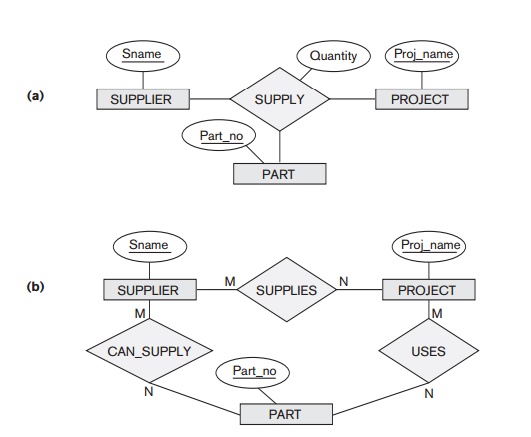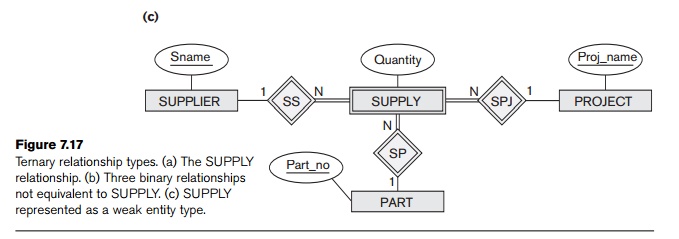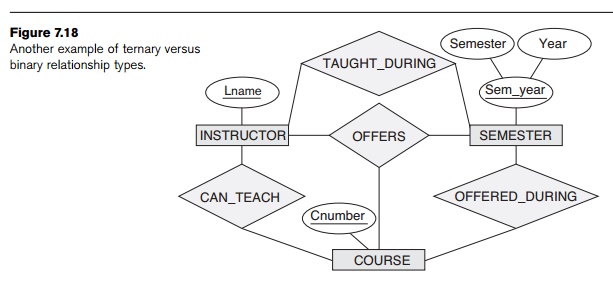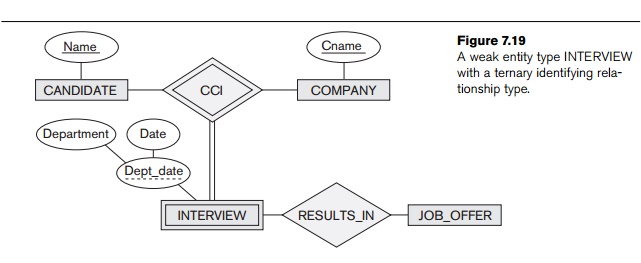Chapter: Fundamentals of Database Systems : Conceptual Modeling and Database Design : Data Modeling Using the Entity-Relationship (ER) Model
Relationship Types of Degree Higher than Two
Relationship Types of Degree Higher than Two
In Section 7.4.2 we defined the degree
of a relationship type as the number of participating entity types and called
a relationship type of degree two binary
and a relationship type of degree three ternary.
In this section, we elaborate on the differences between binary and
higher-degree relationships, when to choose higher-degree versus binary
relationships, and how to specify constraints on higher-degree relation-ships.
1. Choosing between Binary and Ternary (or Higher-Degree) Relationships
The ER
diagram notation for a ternary relationship type is shown in Figure 7.17(a),
which displays the schema for the SUPPLY
relationship type that was displayed at the entity set/relationship set or
instance level in Figure 7.10. Recall that the relationship set of SUPPLY is a set of relationship
instances (s, j, p), where s is a SUPPLIER who is currently supplying a PART p to a PROJECT j. In
general, a relationship type R of
degree n will have n edges in an ER diagram, one connecting
R to each participating entity type.


Figure
7.17(b) shows an ER diagram for three binary relationship types CAN_SUPPLY, USES, and SUPPLIES. In
general, a ternary relationship type repre-sents different information than do
three binary relationship types. Consider the three binary relationship types CAN_SUPPLY, USES, and SUPPLIES. Suppose
that CAN_SUPPLY, between SUPPLIER and PART, includes an instance (s, p)
whenever supplier s can supply part p (to
any project); USES, between
PROJECT and PART, includes an instance ( j, p)
whenever project j uses part p; and SUPPLIES, between SUPPLIER
and PROJECT, includes an instance (s,
j)
whenever supplier s
supplies
some part to project j. The existence of three relationship instances (s,
p), ( j, p), and (s, j)
in CAN_SUPPLY, USES, and SUPPLIES,
respectively, does not necessarily imply that an instance (s, j, p) exists in the ternary relationship SUPPLY, because the meaning is different. It is often tricky
to decide whether a particular relationship
should be represented as a relationship type of degree n or should be broken down into several relationship types of
smaller degrees. The designer must base this decision on the semantics or
meaning of the particular situation being represented. The typical solution is
to include the ternary relationship plus
one or more of the binary relationships, if they represent different meanings
and if all are needed by the application.
Some
database design tools are based on variations of the ER model that permit only
binary relationships. In this case, a ternary relationship such as SUPPLY must be represented as a weak
entity type, with no partial key and with three identifying relationships. The
three participating entity types SUPPLIER, PART, and PROJECT are together the owner entity
types (see Figure 7.17(c)). Hence, an entity in the weak entity type SUPPLY in Figure 7.17(c) is identified
by the combination of its three owner entities from SUPPLIER, PART, and PROJECT.
It is
also possible to represent the ternary relationship as a regular entity type by
introducing an artificial or surrogate key. In this example, a key attribute Supply_id could be used for the supply
entity type, converting it into a regular entity type. Three binary N:1
relationships relate SUPPLY to the
three participating entity types.
Another
example is shown in Figure 7.18. The ternary relationship type OFFERS represents information on
instructors offering courses during particular semesters; hence it includes a
relationship instance (i, s, c)
whenever INSTRUCTOR i offers COURSE c during SEMESTER s. The
three binary relationship types shown in
Figure
7.18 have the following meanings: CAN_TEACH relates
a course to the instructors who can teach
that course, TAUGHT_DURING relates
a semester to the instructors who taught
some course during that semester, and OFFERED_DURING

relates a
semester to the courses offered during that semester by any instructor. These ternary and binary relationships represent
different information, but certain constraints should hold among the
relationships. For example, a relationship instance (i, s, c) should not exist in OFFERS unless an instance (i, s) exists in TAUGHT_DURING, an instance (s,
c) exists
in OFFERED_DURING, and an instance (i,
c) exists
in CAN_TEACH. However, the reverse is not always true; we may
have instances (i, s), (s, c),
and (i, c) in the three binary relationship types with no corre-sponding
instance (i, s, c) in OFFERS. Note that in this example,
based on the mean-ings of the relationships, we can infer the instances of TAUGHT_DURING and OFFERED_DURING from the instances in OFFERS, but we cannot infer the instances of CAN_TEACH; therefore, TAUGHT_DURING and OFFERED_DURING are redundant and can be left
out.
Although
in general three binary relationships cannot
replace a ternary relationship, they may do so under certain additional constraints. In our example,
if the CAN_TEACH relationship is 1:1 (an
instructor can teach one course, and a course can be
taught by only one instructor), then the ternary relationship OFFERS can be left out because it can
be inferred from the three binary relationships CAN_TEACH, TAUGHT_DURING, and OFFERED_DURING. The schema designer must
analyze the meaning
of each specific situation to decide which of the binary and ternary
relationship types are needed.
Notice
that it is possible to have a weak entity type with a ternary (or n-ary) identi-fying relationship type.
In this case, the weak entity type can have several
owner entity types. An example is shown in Figure 7.19. This example shows part
of a data-base that keeps track of candidates interviewing for jobs at various
companies, and may be part of an employment agency database, for example. In
the requirements, a candidate can have multiple interviews with the same
company (for example, with different company departments or on separate dates),
but a job offer is made based on one of the interviews. Here, INTERVIEW is represented as a weak entity
with two owners CANDIDATE and COMPANY, and with the partial key Dept_date. An INTERVIEW entity is uniquely identified by
a candidate, a company, and the combination of the date and department of the
interview.

2. Constraints on Ternary (or Higher-Degree) Relationships
There are
two notations for specifying structural constraints on n-ary relationships, and they specify different constraints. They
should thus both be used if it is
important to fully specify the structural constraints on a ternary or
higher-degree relationship. The first notation is based on the cardinality
ratio notation of binary relationships displayed in Figure 7.2. Here, a 1, M,
or N is specified on each partici-pation arc (both M and N symbols stand for many or any number).15 Let us illustrate this constraint using
the SUPPLY relationship in Figure 7.17.
Recall
that the relationship set of SUPPLY is a set
of relationship instances (s, j, p),
where s is a SUPPLIER, j is a PROJECT, and p is a PART. Suppose that the constraint exists that for a particular project-part
combination, only one supplier will be used (only one supplier supplies a
particular part to a particular project). In this case, we place 1 on the SUPPLIER participation, and M, N on the PROJECT, PART participa-tions in Figure 7.17. This specifies the constraint that a
particular ( j, p) combination can appear at most once in the relationship set
because each such (PROJECT, PART) combination uniquely determines
a single supplier. Hence, any relationship instance (s, j, p) is uniquely identified in the
relationship set by its ( j, p) combination, which makes ( j, p)
a key for the relationship set. In this notation, the participations that have
a 1 specified on them are not required to be part of the identifying key for
the relationship set. If all three cardinalities are M or N, then
the key will be the combination of all three participants.
The
second notation is based on the (min, max) notation displayed in Figure 7.15
for binary relationships. A (min, max) on a participation here specifies that
each entity is related to at least min
and at most max relationship instances
in the relation-ship set. These constraints have no bearing on determining the
key of an n-ary relationship, where n > 2, but specify a
different type of constraint that places restrictions on how many relationship
instances each entity can participate in.
Related Topics